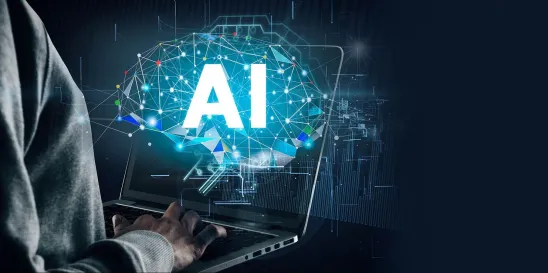President Biden’s Executive Order on the Safe, Secure, and Trustworthy Development and Use of Artificial Intelligence (the “EO”) aims to establish a “coordinated, Federal Government-wide approach” to the development and integration of AI, and directs several federal agencies to undertake a plethora of initiatives and studies regarding the uses, benefits, and potential pitfalls of AI. The EO’s chief directives pertain to the use of AI in the workplace, and President Biden has opined that because AI “creates new jobs and industries, all workers need a seat at the table … to ensure that they benefit from these opportunities.”The EO includes several directives calculated toward advancing and protecting the rights of workers.
While the EO is not technically a new law, rule, or regulation that employers must follow, it certainly represents a harbinger of more guidance to come, including with regard to potential enforcement — particularly with the directives to the US attorney general. Below, we summarize several of these directives and raise additional considerations for workplace implications, including as they relate to directives to the Secretary of Labor, relevant directives to other federal agencies, the importance of employers focusing on education, training, and upskilling, and workplace transition policies.
I. Directives to the Secretary of Labor
The most notable directive to the Secretary of Labor is that the agency must, within 180 days of the EO (and in consultation with other agencies and outside entities, including labor unions and workers), “publish principles and best practices for employers that could be used to mitigate AI’s potential harms to employees’ well-being and maximize its potential benefits.”At a minimum, according to the EO, these principles “shall cover” (i) the risk of job displacement stemming from AI; (ii) the implications AI may have on labor standards and job quality; (iii) the implications for workers of employers’ AI-related collection and use of data about them. After developing these principles, the Secretary of Labor, with the heads of other agencies, “shall consider … encouraging the[ir] adoption.”
Section 6 of the EO further directs the Secretary of Labor to “issue guidance to make clear that employers that deploy AI to monitor or augment employees’ work must continue to comply with protections that ensure that workers are compensated for their hours worked.”
In addition to addressing the potential impact of AI on workers’ rights under the Fair Labor Standards Act, the EO further orders the Secretary of Labor to publish a report “analyzing the abilities of agencies to support workers displaced by the adoption of AI and other technological advancements,” which must, at a minimum: (i) assess how existing federal programs designed to assist workers facing job disruptions could be used to respond to AI-related disruptions; and (ii) identify potential legislative options to strengthen or develop additional support for displaced workers and, in consultation with the Secretaries of Commerce and Education, expand training and education opportunities.
Finally, the EO includes specific directives relating to the hiring of federal contractors. Specifically, to prevent unlawful discrimination from AI used for hiring, the EO instructs the Secretary of Labor to “publish guidance for Federal contractors regarding nondiscrimination in hiring involving AI and other technology-based hiring systems.”
II. Relevant Directives to other Federal Agencies
While most of the directives were addressed to the Secretary of Labor, the EO includes some notable instructions to other agencies relevant to workers, employers, and business leaders. Specifically, the EO addresses potential discrimination in the use of automated systems — including “algorithmic discrimination” — and instructs the assistant attorney general in charge of the US Department of Justice’s Civil Rights Division to convene a meeting with “the heads of Federal civil rights offices” to address how to prevent discrimination in the use of automated systems, and consider what guidance or training is necessary for state and local prosecutors tasked with investigating potential civil rights violations and discrimination arising out of automated systems.
While the EO does not create new laws, this directive may portend future investigations by the DOJ into the use of AI and other automated systems in employment decisions. We have seen these types of laws already enacted, such as New York City’s Local Law 144, which, as we wrote about here and here, prohibits employers and employment agencies from using an automated employment decision tool (“AEDT”) in New York City for such actions as hiring and promotion (or screening in the hiring or promotion process) unless they subject the AEDT to a bias audit and publish required notices, and fulfill other requirements under the law.
The EO includes other directives related to employment, workers, or both,including: (i) instructing the Director of the National Science Foundation to “prioritize available resources to support AI-related education and AI-related workforce development through existing programs”; (ii) encouraging the Federal Trade Commission to consider whether to use its rulemaking authority “to ensure fair competition in the AI marketplace and to ensure that consumers and workers are protected from harms that may be enabled by the use of AI”; and (iii) directing the Chairman of the Council of Economic Advisors to submit a report on the labor-market effects of AI. Additionally, the EO creates a White House AI Council to help coordinate these efforts.
III. Employers Can Help to Prepare Workers Through Education, Training, and Upskilling
As noted above, many of the EO directives address concerns related to job disruptions and displacements and look to harness the power of the federal government to facilitate re-skilling and job training. Specifically, the EO recognizes that “the critical next steps in AI development should be built on the views of workers, labor unions, educators, and employers to support responsible uses of AI that improve workers’ lives, positively augment human work, and help all people safely enjoy the gains and opportunities from technological innovation.” Clearly, many workers will need to obtain new skills, and this has been a recurring alarm as also set forth in the National Artificial Intelligence Initiative Act of 2020, which addressed the need to develop educational and training programs to prepare the workforce to create, use, and interact with AI systems.
Recognizing that the federal government and its agencies may be supportive of employer-sponsored education, training, and upskilling, employers should consider offering programs and benefits to employees to help their workers through the inevitable disruptions caused by AI. For example, employers can:
- Implement qualified educational assistance plans under Section 127 of the Internal Revenue Code that, under current law, can provide tuition reimbursement, as well as payments toward employees’ student loans, up to an overall $5,250 per calendar year through December 31, 2025. Whether there will still be an ability to use these programs for payments toward pre-existing student loan debt after the year 2025 will require an extension under applicable law.
- Offer taxable student loan debt repayment programs to employees to address their student loan debt.
- Pursuant to the SECURE 2.0 Act for plan years after 2023, design 401(k) and 403(b) plans to treat an employee’s student loan payments as elective deferrals for purposes of eligibility to receive employer matching contributions under the plan.
- Provide working condition fringe benefits, under Section 132 of the Internal Revenue Code, to cover educational costs that maintain or improve required skills or meet a condition to maintain a particular job as defined under Section 162 of the Internal Revenue Code. As it becomes increasingly more important for certain employees to re-skill and retool to work alongside machines, employer provision of the requisite education to perform these new jobs may qualify as a working condition fringe benefit.
For workers without access to employer-provided programs, costs for education and training will need to be borne through other means. Future legislation may be passed to address educational costs for students and seasoned workers who need to upskill and retool for future jobs. Employers may also be required to partner with high schools, colleges, and universities to provide job training, internships, and research endeavors to prepare workers for future jobs. Government, educational institutions, and the private sector will likely need to come together to prepare and upskill the workforce and ensure that there is a pipeline of workers with the requisite skills needed for the future workforce.
IV. Workplace Transition Policies
As noted in the EO, workplace disruptions and displacements resulting from advancements in AI are of concern. Employers may wish to proactively consider developing a workplace transition policy, which could include provisions around severance pay, retirement window programs, career-transitioning services, and alternative work arrangements. In structuring these programs, employers must be cognizant of compliance obligations (including anti-discrimination laws) and should be mindful of the impact of these changes on the well-being of their workforce. Employers may wish to identify ways to support workers through this transformation, especially regarding mental health challenges. Programs such as employee assistance plans can offer employees services to work through personal challenges, and employer-provided group health plans can offer mental health benefits on par with the medical/surgical benefits offered in the plan.
Concluding Thoughts
The EO is the latest installment in the Biden administration’s efforts to address the impact of AI, which previously included the Blueprint for an AI Bill of Rights released in October 2022.
As mentioned above, while the EO is not technically a new law, rule, or regulation that employers must follow, it certainly represents a harbinger of more guidance to come. The immediate impact of the EO is felt by federal agencies, which must act within the time periods specified in the EO — ranging from as few as 30 days to as many as 365 days. Yet, as noted in the EO, harnessing AI for good and realizing AI’s myriad benefits requires mitigation of its substantial risks, and that it is an endeavor that demands a society-wide effort that includes government, the private sector, academia, and civil society.




 />i
/>i
